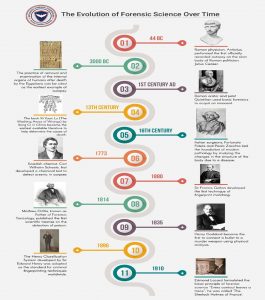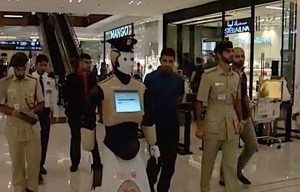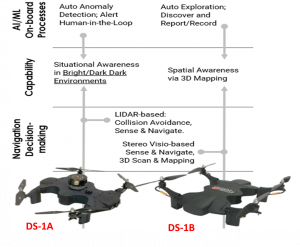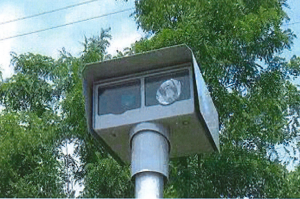18 Practical Crime Scene Investigation (CSI) Using Autonomous Systems
By Wayne D. Lonstein Esq. & Dr. Hans C. Mumm
Student Learning Objectives
The student will gain knowledge of the concepts and framework related to the use of autonomous systems to enhance crime scene investigations.
This chapter will include the challenges of crime scene airspace and the evidentiary collection and accepted use during the prosecution phase of criminal cases.
A Look Back at the Science of Crime Scene Investigation (CSI)
It has been said that “modern crime scene investigators combine the logic of fictional detective Sherlock Holmes with advanced scientific techniques in identifying and processing evidence.” (Franklin, 2020)
The historical perspective of CSI starts with an understanding that forensic science is most often associated within the legal system as “the application of scientific methods and principles to questions of law. Or, in layman’s terms, forensic science is a discipline used by a forensic investigator to solve crimes.” (Exploring The History Of Forensic Science Through The Ages, 2022)
Antistius, a Roman physician of Julius Caesar, completed the first autopsy. During the 12th Century, the Chinese were credited with “being the first to attempt to define the difference between natural death and Criminal intent.” (Exploring The History Of Forensic Science Through The Ages, 2022)
Figure 18.1. A Timeline of the History of Forensic Science

Source: (Exploring The History Of Forensic Science Through The Ages, 2022)
Today crime scene investigation is an organized activity using the “solid foundation developed over thousands of years of forensic investigation. Modern forensics built upon these technologies and expanded their application to include computer forensics, DNA forensics, entomological (insect) forensics, and enhanced biological studies. Crime scene investigation continues to experience rapid technological advancements”. (Taylor, 2018)
Challenges of CSI in Hot Zones-Why Not Use Robots?
Historically, crime scene evidence collection has been done only by humans; however, with advancing robotics, sensors, and the ability to demonstrate to courts that the evidence was collected to today’s standards or higher, why would we not use this technology?
Currently, seven autonomous systems are recognized: unmanned aircraft systems (UAS) (drones), unmanned ground vehicles (UGV), unmanned underwater vehicles (UUV), unmanned surface vessels (USV), humanoids, cyber, and exoskeletons. In light of the past few years of a worldwide pandemic, we now must add “nano biologics” to this list and recognize eight autonomous systems. All can do an incredible amount of good for the human race while recognizing they can all be used in evil ways, creating great harm to humanity, our planet, and our future.
This chapter will narrow the focus to examine the use of UAS (with a USV variant) and USV in CSI CBNRE (chemical, biological, nuclear, radiological, and explosive). The idea behind unmanned systems is to allow these machines to handle dull, dirty, and dangerous situations for humans, contrary to deploying a human, who must be decontaminated after going into a hot zone. Dr. David Cullen summed up the CBNRE threat by stating:
CBRN(E) weapons are becoming more frequent and increasingly lethal globally. Future military operations are envisioned to be more diverse, contested across all domains, and require rapid decision-making to enable decisive maneuver. Defense forces must sense hazards more rapidly, at a greater speed, increase stand-off distance, and share intelligence faster throughout the formation. (Cullen, 2021)
In a hot zone, decontamination may not be advised depending on the contaminants in the environment. The disposal of the unmanned system might be a better option, as all of the collected CSI information will have been downloaded, cataloged, and stored. Autonomous systems can be easily sanitized before entering a crime scene, and their movements are recorded and cataloged. In contrast, their movements are more precise throughout a crime scene than a human. This becomes critical as it is “simply impossible for anyone to enter a location without changing it somehow, either by bringing something to it or removing something from it. The latter statement is known as the Locard Exchange Principle.” (Fisher, 2000)
Consider the search for corpses after a CBNRE incident. Autonomous systems can be relatively low cost, allowing for a scene’s saturation and an extensive jurisdiction with minimal manning requirements. These systems are “easy to operate, and can be used in a wider variety of environments and closer proximities, but they are limited in the camera load they can carry. Airspace regulations often restrict them to the line of sight flights.” (Butters, 2021)
Traditional methods of cadaver detection in outdoor environments include manual ground search, cadaver dogs, and manned aerial reconnaissance during daylight. However, these methods have limitations; a potential low-cost alternative may be to employ thermal imaging equipment mounted on an unmanned aerial vehicle (UAV) to detect heat emitted by insects and bacterial activity on the decomposing remains. (Butters, 2021)
The ability of autonomous systems to augment, supplement and assist in CBNRE incidents is just being explored. Multiple autonomous systems can integrate and team to gather evidence in several new, efficient, and effective ways unavailable in years past.
Autonomous Systems Technology to Augment Human CSIs
In May 2017, the Dubai police swore in the first law enforcement robot; the first Robocop model is a citizen-friendly, helpful version. The follow-on version is more advanced as they are “immune from diseases and viruses; hence, nor can they feel hungry or thirsty. For this reason, they have already proven ideal for rescue missions — already they serve in bomb disposal — or, for example, in radioactive or chemically contaminated areas”. (Robocop becomes real-world: robot law enforcement in Dubai may bring Robocop to a neighborhood near you, 2017)
Figure 18.2 Law enforcement humanoid in Dubai shopping mall

Source: (“Robocop becomes real-world: robot law enforcement in Dubai may bring Robocop to a neighborhood near you,” 2017).
Figure 18.3 Law enforcement humanoid in a public space

Source: (“Robocop becomes real-world: robot law enforcement in Dubai may bring Robocop to a neighborhood near you,” 2017).
The concept of purpose-built autonomous systems to augment and assist CSIs is a logical next step for law enforcement as crime rates continue to climb and our criminal justice systems are overworked. Autonomous systems can help in reducing unwanted errors from overworked officers.
The importance of CSI has only grown over the years; however, “police handling many cases can find one case blurs into another-a very human reaction,” which offers more reasons for autonomous systems to augment human CSIs. (Fisher, 2000)
Today, CSI is an “umbrella term often used to refer to various methods and techniques applied during a criminal investigation. Focused on discovering, recovering, and processing evidence, crime scene investigation applies reasoned principles to pursue truth”. (Franklin, 2020) Small steps forward, starting with tried-and-true UAVs (with a USV variant) and UGVs, would allow testing of evidence collection, storage, chain of custody, and data integrity without compromising the investigations.
Autonomous systems offer the capabilities that will extend the range of evidence collection and hopefully assist in higher rates of prosecutions. An autonomous system can have “onboard UAV cognition capabilities for understanding and interacting in environments with imprecise or partial observations, for objects of interest within complex scenes.” (Sandino, 2021)This increase in cognitive depth “allows (s) UAVs to collect more accurate victim coordinates than the baseline planner. Adding the proposed system to UAVs improves robustness against potential false positive readings of detected objects caused by data noise, inaccurate detections, and elevated complexity to navigate time-critical applications.” (Sandino et al., 2021)
Virtual Reality-Teaching and Learning in Crime Scene Investigations
Virtual reality (V.R.) and augmented reality (A.R.) have been used in gaming. This technology is now being implemented in several training environments, from driving, flying, and shooting simulator to law enforcement and military training scenarios. Research has been done in a multi-disciplinary study where a “V.R. crime scene app was designed and implemented, after which both undergraduate student tested it and staff/postgraduate student cohorts…demonstrate(d) that V.R. applications support learning of practical crime scene processing skills.” (Mayne, 2020)
The need to train and hone the skills of experienced CSI and now autonomous systems will benefit from a 3D world whose graphical resolution and frame rates can approach those of ‘real life’ and hence offer an immersive and worthwhile experience…VR-based practical sessions have the potential to add value to forensic science courses through offering cost-effective practical experience (and) the ability to work in isolation and a variety of different scenarios (Mayne, 2020)
CBNRE Scenes-Terrorist Attack or Accident-Autonomous Systems Can Help
Combining air and ground autonomous systems offers new ways to employ CSI in CBNRE scenes. The ability of the autonomous systems to not only integrate and team together as machines can now be expanded to manned-unmanned teaming arrangements known as MUM-T, with the trust factor being created with a “conceptual architecture for making humans, cyber systems, and physical systems working together in optimal complementarity by taking advantage of the strengths of both human intelligence and machine intelligence.” (Bousdekis, 2020) The idea behind these teams of humans and machines assists in addressing “the challenge of prolonged autonomous navigation within environments, for which a limited amount of information is available before deployment.” (Papachristos, 2014)This concept can be adapted by law enforcement based on the success the United States military is seeing as “Manned-unmanned teaming (MUM-T) operations combine the strengths of each platform to increase situational awareness, allowing the armed forces to conduct operations that include combat support and intelligence, surveillance, and reconnaissance (ISR) missions.” (Iriarte, 2016)
Humans and machines can work in harmony, and an extensive study effort is currently underway to create this harmony which “provides the means to support human-AI symbiosis ecosystem and effectively manage the emerging generation of artificially intelligent partners, offering explainable value through automated reasoning aiming at assisting and facilitating the work of the Operator.” (Bousdekis, 2020)
Most UGVs are equipped with point detection sensors, ready to sample the environment to verify a CBNRE incident and collect evidence. In addition, the next generation of UGVs will offer “Integration and maximum use of stand-off sensing could reduce the potential risk of operators being exposed to CBRN hazards.” (Cullen, 2021).
Autonomous systems offer, in time, the ability to collect needed information without disturbing the crime scene to the extent humans do, no matter how careful humans are as “It is simply impossible for anyone to enter a location without changing it in some way, either by bringing something to it or removing something from it. The latter statement is known as the Locard Exchange Principle. (Fisher, 2000)
Several variants of UGVs are available on the market; Figure 18.4 shows an example of the FLIR Centaur-medium-sized UGV, which provides a stand-off capability to detect, confirm, identify, and dispose of hazards. (Cullen, 2021)
Figure 18.4 UGV assisting at an IED site

Source: (Cullen, 2021)
Over the years, many different types of wireless controlled and wireless controlled UGVs offered bomb disposal units a way to deal with dangerous situations without putting humans at risk. The evolution of sensors, long-life batteries, data links, and advanced programming allows the exploration of using this technology in CBNRE environments to collect CSI data from prosecuting the crime. Table 18.1 below examines the Pros and Cons of using UGVs in CSI environments.
Table 18.1 Pros & Cons of UGVs supporting CSI environments
Pros
Long dwell time
High sensor & carrying capacity
Ability to carry/drag humans to safety
Less Disruption to crime scene
CONs
Difficult maneuvering on stairs and complex environments
Require “mapping” of building layout to function in autonomous mode
Heavy and difficult to retrieve
Limited field of view and situation awareness
UAVs offer several advantages at a crime scene. Rapid deployment and a different perspective of crime scenes allow for a more in-depth investigation and lines of inquiry that standard human height perspectives offer. Many police departments are already investigating the use and reliability of these systems, “The Royal Canadian Mounted Police started using Unmanned Aerial Vehicles to help them work on collision and crime scene investigation. It allows the investigations to be conducted under all weather conditions and provides broader views than the traditional procedures.” (UAVs Bring New Dimension In Crime Scene Investigation, 2021)
Figure 18.5 Investigator using a UAV at a crime scene Examining UAV use in CSI-Crash Scene Photo Royal Canadian Mounted Police

Source: (UAVs Bring New Dimension In Crime Scene Investigation, 2021)
Using the combination of image acquisition by UAV and mapping software, the UAV provides “a complete solution to reconstruct accident and crime scenes and solves vital issues not covered by traditional methods.” (“UAVs Bring New Dimension In Crime Scene Investigation,” 2021) Table 2 offers some Pros and Cons of using UAS technology at crime scenes.
Table 18.2 Pros and Cons of UAS in a CSI environment
PROs
Rapid deployment
Can operate in GPS denied environment
Sensor packages allow for a high level of situation awareness
Ability to easily use in a MUM-T operation and uncouple to return to independent operations
CONs
Rotor wash could disrupt crime scene, contaminating collection efforts
A high level of air movement could further disperse CBNRE
Limited weight carrying capacity-limits airtime and payloads
Limited to no ability to assist or move humans from danger
Source: (“UAVs Bring New Dimension In Crime Scene Investigation,” 2021)
Many crime scenes are indoors, commonly known as a GPS-denied environment. Several solutions are being worked on to deal with this limitation. For example, a UAS company, Airgility, in College Park, Maryland, is working on combining A.I. autonomous flight with a series of different size UAS that can operate in GPS-denied areas. This will allow “GPS-denied autonomy in confined spaces such as buildings and silos. As a result of the robotic operations and human-in-the-loop operability, a decision-making advantage is achieved via autonomous robotic workflow and edge-processed analytics.” (Valente, 2022). In addition, the DS-1 series “was developed for Department of Homeland Security (DHS) applications about flight autonomy for confined and harsh environments.” The onboard LIDAR allows the vehicle to understand its surroundings without a GPS signal. The vehicle can transition from GPS flight into a GPS-denied area allowing for greater flexibility in mission planning and use in the uncertainty of a crime scene, providing analytical feedback in real-time.
Figure 18.6. Side by Side Comparison of DS-1A and DS-1B UAVs

Source: (Valente, 2022)
The concept of unmanned robotic teams” consisting of an aerial and a ground vehicle, and a power-tethering physical link between them, and proposes a strategy that addresses their collaborative navigation problem.” (Papachristos, 2014)
The rapid development of autonomous systems for law enforcement is directly related to their ability to be used in CBRNE environments with the expectation of “unmanned aerial vehicles of exceptional capabilities, unmanned ground vehicles as well as marine and hybrid autonomous robots…to exploit the operational advantages of different unmanned vehicle classes.” (Papachristos, 2014) Combining this with human teams and crime scene investigation in a CBNRE environment is the reality that will yield high-fidelity data for use in prosecuting these crimes.
Legal Considerations for Autonomous Systems Use at a Crime Scene
According to the National Institute of Science and Technology, Forensic Science is “Forensic science is the use of scientific methods or expertise to investigate crimes or examine evidence that might be presented in a court of law.” (NIST, 2022) Since 1902 modern forensic science has embraced new technologies to assist in investigating crime beginning with fingerprints analysis in 1902 to the polygraph, voice, DNA, and widespread use of automated collection and analysis in the 21st Century. Just fingerprint technology alone has evolved from the ancient to the cutting edge and has accelerated by technological automation in the last half-century.
Figure 18.7 A Timeline of Fingerprint Firsts

Source: (Justice, 2014)
While it seems new technology is created for forensics each day, automation needs thorough examination before implementation. In the 1923 decision, Frye v. the United States, the United States Circuit Court for the District of Columbia established a rule for admitting expert testimony based upon technology or scientific information. The court wrote:
“When a scientific principle or discovery crosses the line between the experimental
And demonstrable stages are difficult to define. Somewhere in this twilight zone, the evidential force of the principle must be recognized. While courts will go a long way in admitting expert testimony deduced from a well-recognized scientific principle or discovery, the thing from which the deduction is made must be sufficiently established
to have gained general acceptance in the particular field in which it belongs.” (Frye v. the United States, 1923)
The intersection of forensic science and automated technology continually requires additional rules regarding the myriad of new and sometimes unproven, being admissible in courts. The Supreme Court of the United States provided an opinion regarding the “General Acceptance” rule established in Frye. In Daubert v. Merrell Dow Pharmaceuticals (Daubert v. Merrell Dow Pharmaceuticals, 1993), the Supreme Court issued new guidance relating to scientific evidence to trial courts. As a result, Federal Rule of Evidence 702 now requires the following factors to be laid as a foundation for scientific evidence:
FRCP 702: a witness who is qualified as an expert by knowledge, skill, experience, training, or education may testify in the form of an opinion or otherwise if:
(a) The expert’s scientific, technical, or other specialized knowledge will help the
the trier of fact to understand the evidence or to determine a fact in issue;
(b) The testimony is based on sufficient facts or data;
(c) The testimony is the product of reliable principles and methods, and;
(d) The expert has reliably applied the principles and methods to the facts of the case. (Federal Rules of Evidence 702, 2000)
While some states still follow Frye’s “General Acceptance” standard, most federal courts follow Rule 702. Individuals intending to be forensic examiners or subject matter experts must describe the significance of the evidence, explain how the technology works, and prove the process based upon scientific principles and methods. The forensic witness must show how the technology works and that the technology is considered scientifically reliable. In this particular case, the process, whether a blend of human and technology or solely automated, was conducted according to all established principles for that technology. It is not simply enough to testify about the results; the presenter must also demonstrate how it works and that all technology rules are meticulously followed.
Failure to satisfy these requirements can be devastating to the party relying upon the evidence. In the sensationalized 1994 case of California vs. Orenthal James Simpson, forensics took the world stage with multiple types of scientific evidence and expert testimony offered by the parties. (People of the State of California v. Orenthal James Simpson, 1995)
Figure 18.8. Dr. Henry Lee, examining evidence

Source: (Court TV, 1994)
Simpson’s defense team called Dr. Lee to testify on behalf of Defendant O.J. Simpson. Dr. Lee’s testimony created doubt in the jurors’ minds that the Los Angeles Police Department failed to comply with foundational crime scene forensic rules, resulting in “untrustworthy” results. The defense called additional experts to testify that both the science was not “reliable” and the process of collecting evidence provided to the technology operator was tainted and therefore not sufficient to prove a case of intentional murder.
Figure 18.9 Glove demonstration from the Simpson trial. The gloves did not fit.

Source: (The 1995 Blog, 2020)
Autonomous Evidence: If You Can’t Explain It, Courts Will Not Allow It
Whether manual, hybrid, or autonomous, forensic evidence collection, analysis, or conclusion; the forensic witness must be able to explain to the court:
- How the technology works;
- Establish that the science is reliable and accepted in the scientific community (Daubert v. Merrell Dow Pharmaceuticals, 1993);
- Explain the requirements for a forensically sound collection of evidence;
- The Crime Scene Analyst collected per the developer’s specification;
- The technology was tested for proper functioning before, during, and after the analysis; and
- The results provided were under the normal functioning or process of the technology and acceptable ranges.
Figure 18.10. Automated Speed Enforcement Technology

Source: (Missouri Department of Transportation, 2018)
Forensic investigators should be ready to answer questions relating to what they did on a crime scene or what technology they used; they must explain how it functions. One need only look at the 2021 Kyle Rittenhouse murder trial in Kenosha, Wisconsin, as an example. As part of the prosecution’s case, technology-enhanced drone video of the shooting was used as evidence. The court struggled to understand whether the technology changed or altered the video.
Figure 18.11. Scenes from the Rittenhouse courtroom

Source: (AP, 2021)
Upon questioning the court, the prosecution could not articulate how the technology worked and, more importantly, assure the court that the original content was unaltered instead of highlighted. Although the requirements of Daubert & Frye were eventually satisfied, the problem stemmed from the prosecution’s inability and its’ witnesses’ inability to explain how the technology used to create it worked. The fact jeopardized the prosecution case and may have raised doubt in the jurors’ minds, eventually acquitted Rittenhouse.
The takeaway is that no matter how well the technology performs, unless it can be explained “how it works” and “why it is reliable,” the case can be jeopardized.
Conclusions
Criminals and terrorists are not bound by any restrictions that hamper law enforcement; they are free to innovate and use technology, CBNRE, and other tactics required to obtain their goal. History dictates what is considered the use of technology “as the Reno gang “invented” train robbery in 1866, and Jesse James pioneered daylight bank robbery a few years later, so modern felons labor nonstop to take full advantage of new technology, seeking more efficient ways to beat the system and avoid detection in the process” (Newton, 2008).
It is time for autonomous systems to augment and integrate into crime scene investigation. The technology has matured to the point of certainty. The laws, policies, and governance should be updated to match the reality of the modern crime scene and the increasing use of CBNRE around the world. It has been said that “High-Tech crimes are defined by their era” (Newton, 2008), and we are living in the next evolution of crime as we seek Justice for crimes committed against our modern societies.
Questions
- Is there a difference between a human collecting crime scene data and an autonomous system?
- CSI data is based on science. Do you think autonomous systems are better to augment a human CSI at a scene or replace the human?
- List three considerations for airspace usage in using a UAV for CSI collection at a crime scene.
- What legal ramifications could occur with using autonomous systems at a crime scene?
- Name three ways the law enforcement community and a prosecutor could benefit from using autonomous systems at crime scenes.
Bibliography
Bousdekis, A. A. (2020). A human cyber-physical system framework for operator 4.0 – artificial intelligence symbiosis. Manufacturing Letters, pp. 25, 10-15. doi:10.1016/j.mfglet.2020.06.001.
Butters, O. K. (2021). Application of forward‐looking infrared (FLIR) imaging from an unmanned aerial platform in the search for decomposing remains. Journal of Forensic Sciences, pp. 66(1), 347-355. doi:10.1111/1556.
Cullen, D. (2021). From A Distance. Retrieved from cbnw.co.uk/: https://cbnw.co.uk/from-a-distance-flir/
Exploring The History Of Forensic Science Through The Ages . (2022). Retrieved from //ifflab.org/: https://ifflab.org/history-of-forensic-science/
Fisher, B. A. (2000). Techniques of crime scene investigation (6th ed.). CRC Press.
Franklin, C. (2020). Crime scene investigation. In: Salem Press. Salem Press.
Iriarte, M. (2016). MUM-T operations on the U.S. Army’s UAS roadmap. . Retrieved from militaryembedded.com/: https://militaryembedded.com/unmanned/isr/mum-t-armys-uas-roadmap
Justice, U. S. (2014). The Fingerprint Sourcebook. CreateSpace Independent Publishing Platform.
Mayne, R. &. (2020). Virtual reality for teaching and learning in crime scene investigation. Science & Justice, pp. 60(5), 466-472. doi:10.1016/j.scijus.2020.07.006.
Missouri Department of Transportation. (2018). Automated Enforcement Survey. Jefferson City, Missouri: Missouri Department of Transportation.
Newton, M. (2008). The encyclopedia of crime scene investigation: Facts on File.
NIST. (2022). Definition of Forensic Science. NIST / GPO.
Papachristos, C. &. (2014). The power-tethered UAV-UGV team: A collaborative strategy for navigation in partially-mapped environments. Retrieved from 22nd Mediterranean Conference on Control & Automation, 1153-1158. : https://search.ebscohost.com/l
Robocop becomes real-world: robot law enforcement in Dubai may bring Robocop to a neighborhood near you. (2017). Retrieved from Robocop becomes real-world: robot law enforcement in Dubai may bring Robocop to a neighborhood near you. (2017). Retrieved from https://www.ediweekly.com/robocop-becomes-real-world-robot-law-enforcement-dubai-may-bring-robocop-neighborhood-near/: https://www.ediweekly.com/robocop-becomes-real-world-robot-law-enforcement-dubai-may-bring-robocop-neighborhood-near/
Sandino, J. M. (2021). Drone-Based Autonomous Motion Planning System for Outdoor Environments under Object Detection Uncertainty. Remote Sensing. Remote Sensing, pp. 13(21), 4481. doi:10.3390/rs13214481.
Taylor, S. (2018). history-crime-scene-investigation. Retrieved from //careertrend.com/: https://careertrend.com/about-5371617-history-crime-scene-investigation.html
The 1995 Blog. (2020). Too tight’: The botched glove demonstration at O.J.’ Trial of the Century’ in 1995. Retrieved from The 1995 Bog: https://1995blog.com/2020/06/12/recalling-botched-glove-demonstration-at-1995-o-j-simpson-trial-of-the-century/
UAVs Bring New Dimension In Crime Scene Investigation. (2021). Retrieved from www.dronethusiast.com: https://www.dronethusiast.com/uavs-bring-new-dimension-crime-scene-investigation/
Valente, E. (2022). Airgility. Retrieved from www. airgility. co/: https://www.airgility.co/

